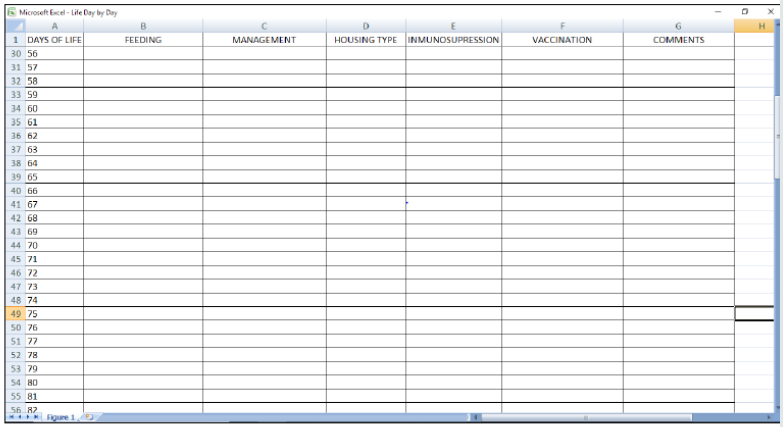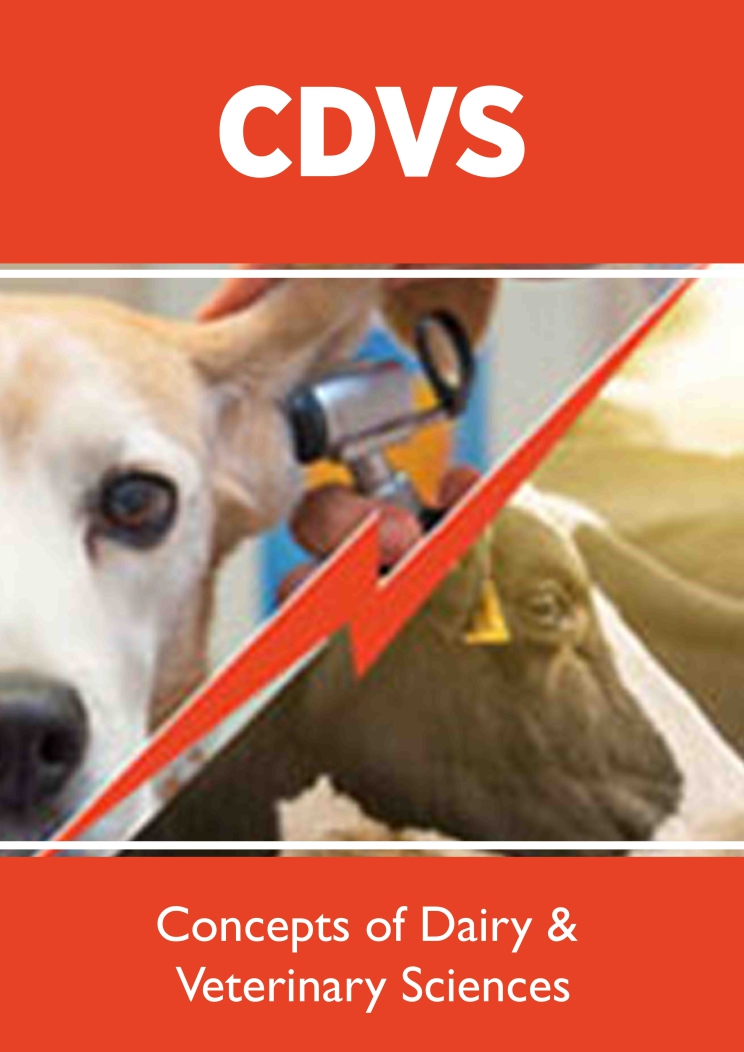
Lupine Publishers Group
Lupine Publishers
Menu
ISSN: 2637-4749
Research Article(ISSN: 2637-4749) 
Combined on-Farm Analysis of Management Procedures and Vaccination Protocols: The Way to Maximize the Health of the Herd Volume 3 - Issue 1
Ramon Armengol1* and Marta Bassols1
- 1Department of Animal Science, University of Lleida, Spain
Received: October 29, 2019; Published: November 26, 2019
Corresponding author: Ramon Armengol, Department of Animal Science, University of Lleida, Spain
DOI: 10.32474/CDVS.2019.03.000155
Abstract
During a farm animal’s life, there are a lot of situations that carry stress and induce immunosuppression, increasing the risk of infections and diseases. At the same time, veterinarians and farmers make a big effort (technical and economical) to increase immunity, setting complete vaccination programs. Frequently, this prevention through vaccination fails because administration is carried out during immunosuppression periods. We propose an easy, accurate and understandable strategy based on a complete visit of the farm and interview with the farmer. It is purposed to analyze altogether management procedures on farm, other phenomena and vaccination protocols that occur during the ruminant’s life. After a deep analysis, we suggest changes in the farm’s routine in order to maximize health status of the ruminants, reducing stress and immunosuppression periods, increasing efficacy of vaccines and efficiency of the production system. This strategy includes the analysis of the ruminants’ life, day by day, through a spreadsheet.
Keywords: Advice; cattle; management; ruminants; stress
Introduction
Increase or maximize the health of the ruminants in a herd
should be a priority for both farmers and veterinarians. Since
long, the use of vaccines in order to directly increase immunity
but also reduce amount of pathogens in the herd and reduction
of clinical signs in infected animals has been carried out [1-3]. It
is also well known that stress factors have a negative impact on
the immune system and ruminants submitted to it might suffer
from stress-induced immunosuppression during several days [4].
Farm animals are submitted to management, physiological status
and environment that can induce stress [4,5]. Even when this
management is carried out properly and welfare is excellent in the
farm, ruminants can be under 30 immunosuppression for a period
of time that ranges from hours to weeks [4,6,7].
This stress may, directly or indirectly, induce a decrease of
vaccination efficacy, above all when administration of the vaccine is
done during this period of immunosuppression. Ideally, ruminants
should not be vaccinated during these immunosuppression periods.
On the day by day of a farm, this golden rule is often forgotten,
and vaccinations are done under stress or immunosuppression
periods. Veterinarians tend to assume that vaccination protocols
and management strategies they advise for are correctly done. The
reality is that on farm routine brings to a bias in between what is
set and what is done. The main objective of this manuscript is to
provide a strategy for veterinarians, farmers and advisors in order
to identify stress periods and vaccine administrations, evaluate if
an increase of health and efficiency can be achieved.
Material and Methods
For this strategy a spreadsheet with several columns and
multiple lines (Figure 1) is needed and an interview with the
farmer/herd manager that will last 1 to 2 hours will be agreed. It
is recommended to have agreed an appointment time before, it is
crucial not to be in a hurry and start and finish the interview at
once. It is also recommended to have this appointment visiting the
farm and the animals, as if it was the first time you are in that farm.
Data collected will be all the stressing management, practices or
statuses that occur in a farm from day 0 of life until completing first
lactation, including dry off and the second parturition. Most common
stress factors must be detailed, and the immunosuppression period
attributed. It is also essential to detail all the different feeding and allocation that ruminants will have during the period under study.
Finally, all the vaccination protocols will be detailed (product and
day of administration -age or day after parturition-). All this data
will be in columns and placed in the spreadsheet cell corresponding
to the day that is done (Figure 2).
Figure 2: Detailed and completed information needed for analysis between 56 to 84 days of a dairy heifer’s life. PCS: number of calves. BRSV (Bovine Respiratory Syncytial Virus), PI-3: Bovine parainfluenza type 3 virus. BVDV (Bovine viral diarrhoea); IBR (Infectious Bovine Rhinotracheitis); BRD (Bovine Respiratory Disease).
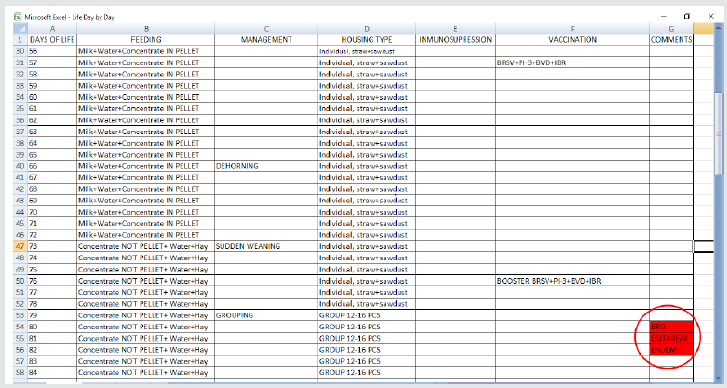
Results and Discussion
The result of this appointment and post office work will be a
spreadsheet full of different information that includes nutrition,
management, immunosuppression, vaccination and disease.
This way to gather information, will allow the advisor to detect,
very quickly, unwanted phenomena in a farm, which reduce
the health status of the animals. It will be easy to detect failures
in the application of vaccinations under periods of stress or
immunosuppression, different management too close together
in time or too many stressing changes at once (i.e. grouping and
change of feeding the same day).
Furthermore, it allows the consultant to suggest changes in the
tempos of conducting management practices or suggest changes in
the days of vaccination so that they do not coincide with periods of stress and immunosuppression. Thus, maximizing the potential
of vaccinations, not only in their ability to generate immunity, but
also just when it is desired to generate immunity. As examples,
vaccination for respiratory pathogens is strongly recommended
at least 2 weeks before transport or grouping and vaccination for
BVDV is strongly recommended 3 to 4 weeks before insemination/
matting in order to avoid abortion or persistently infected bovines.
Surprisingly, the advisor can sometimes suggest changes that will
be better for health status but also for the production costs of the
farmer. As an example, reduction on feeding milk replacer to calves
without any impact on performance (Figures 3 & 4).
Figure 3: Critical point in the heifer rearing process in a dairy farm. Blue oval shows the stress factors in orange (late dehorning, sudden weaning and grouping) in 15 days and the immunosuppression caused, having a negative impact on the booster of respiratory disease vaccination (in red). Red oval shows the consequence: endemic respiratory disease in this group of animals. PCS: number of calves. BRSV: Bovine respiratory syncytial virus. PI-3: Bovine parainfluenza type 3 virus. BVDV: Bovine viral diarrhoea. IBR: Infectious bovine rhinotracheitis. BRD: Bovine respiratory disease.
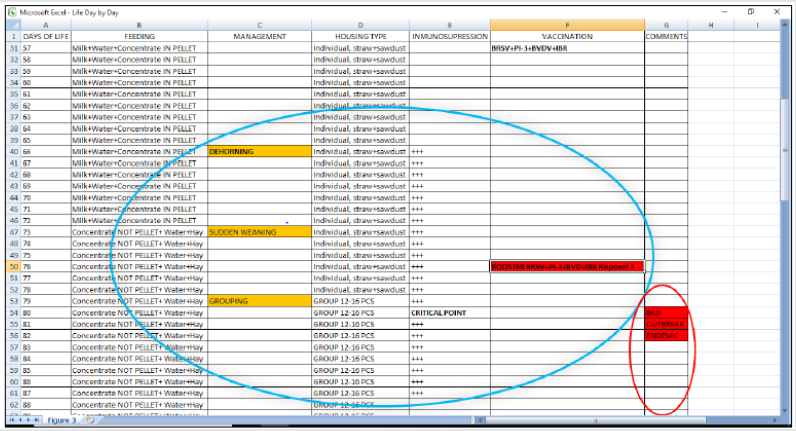
Figure 4: Final management and vaccination schedule after analysis of situation described in Figure 3.
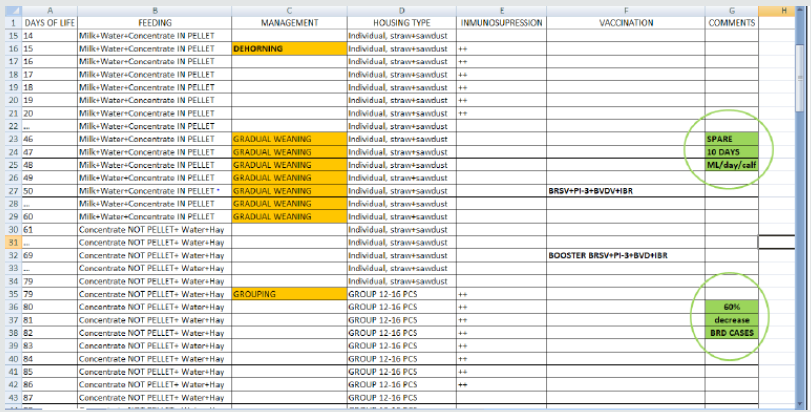
Blue oval shows the stress factors in orange (late
dehorning, sudden weaning and grouping) in 15 days and the
immunosuppression caused, having a negative impact on the
booster of respiratory disease vaccination (in red). Red oval shows
the consequence: endemic respiratory disease in this group of
animals. PCS: number of calves. BRSV: Bovine respiratory syncytial
virus. PI-3: Bovine parainfluenza type 3 virus. BVDV: Bovine viral
diarrhoea. IBR: Infectious bovine rhinotracheitis. BRD: Bovine
respiratory disease.
Changes on management procedures, timing on management
and vaccination protocol reduced respiratory disease after
grouping. Decisions taken were: Dehorning at 15 days of age,
gradual weaning and vaccination protocol started a week earlier.
Results were a spare of milk and a 60% decrease of BRD cases. PCS:
number of calves. BRSV: Bovine respiratory syncytial virus. PI-3:
Bovine parainfluenza type 3 virus. BVDV: Bovine viral diarrhoea.
IBR: Infectious Bovine Rhinotracheitis. BRD: Bovine respiratory
disease. ML: Milk
Conclusion
Continuous and detailed review of management procedures together with stress factors and vaccination protocols in ruminants’ farms is needed to maximize health status. This audit must be individualized. Results and changes set must be written, analyzed and described in an easy, accurate and understandable way for the farmer.
References
- Lacasta D, Ferrer LM, Ramos JJ, González JM, Ortín A, et al. (2015) Vaccination schedules in small ruminant farms. Veterinary Microbiology 181(1-2): 34-46.
- Stokka G, Goldsmith T J (2015) Feedlot Vaccination: Does It Really Matter? Vet Clin North Am Food Anim Pract 31(2):185-196.
- Noorduhuizen JP (2015) Role of vaccination in dairy herd health and productivity.Veterinary Record 177(18): 463.
- Collier RJ, Renquist BJ, XiaoY (2017) A100-Year Review: Stress physiology including heat stress. Journal of Dairy Science 100(12):10367-10380.
- Chebel RC,Silva PRB, Endres MI, Ballou MA, Luchterhand KL (2016) Social stressors and their effects on immunity and health of periparturient dairy cows. J Dairy Sci 99(4):3217-3228.
- Caroprese M, Albenzio M,Marzano A, Schena L, Annicchiarico G, et al. (2010) Relationship between cortisol response to stress and behavior, immune profile, and production performance of dairy ewes. Journal of Dairy Science 93(6): 2395-2403.
- Hulbert LE, Sonia JM (2016) Stress, immunity, and the management of calves. J Dairy Sci 99(4):3199-3216.

Top Editors
-

Mark E Smith
Bio chemistry
University of Texas Medical Branch, USA -

Lawrence A Presley
Department of Criminal Justice
Liberty University, USA -

Thomas W Miller
Department of Psychiatry
University of Kentucky, USA -

Gjumrakch Aliev
Department of Medicine
Gally International Biomedical Research & Consulting LLC, USA -

Christopher Bryant
Department of Urbanisation and Agricultural
Montreal university, USA -

Robert William Frare
Oral & Maxillofacial Pathology
New York University, USA -

Rudolph Modesto Navari
Gastroenterology and Hepatology
University of Alabama, UK -

Andrew Hague
Department of Medicine
Universities of Bradford, UK -

George Gregory Buttigieg
Maltese College of Obstetrics and Gynaecology, Europe -

Chen-Hsiung Yeh
Oncology
Circulogene Theranostics, England -
.png)
Emilio Bucio-Carrillo
Radiation Chemistry
National University of Mexico, USA -
.jpg)
Casey J Grenier
Analytical Chemistry
Wentworth Institute of Technology, USA -
Hany Atalah
Minimally Invasive Surgery
Mercer University school of Medicine, USA -

Abu-Hussein Muhamad
Pediatric Dentistry
University of Athens , Greece

The annual scholar awards from Lupine Publishers honor a selected number Read More...




